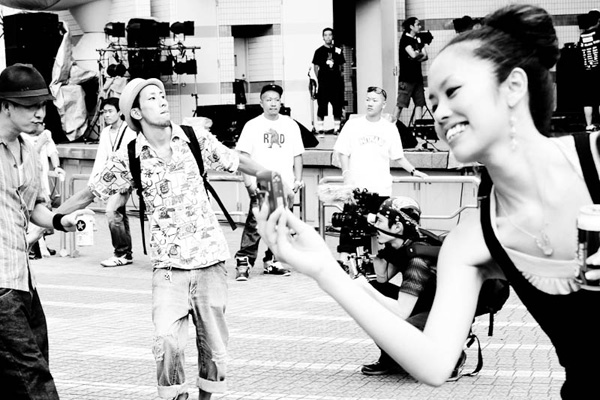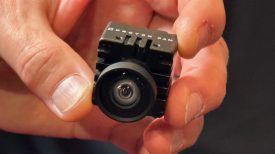‘Children of Enlightenment’ is a documentary about youth culture in Japan, its uniqueness, its creativity, and its reflection of the state of Japan’s economy and society.
SYNOPSIS
‘Children of Enlightenment’ is a revolutionary documentary that aims to become the chronicle of a generation – namely, young Japanese people, who are in the process of leading their country into a creative renaissance. Rejecting – and rejected by – the secure corporate jobs of the past, Japan’s youth are asserting their individuality by diving into creative pursuits like art, fashion, and music. ‘Children on the Enlightenment’ guides its audience into this creative scene, following the youth to the places where they work, play, live, and create. The film explores the new lifestyles and new philosophies with which these young people experiment. Through interviews with older established artists the documentary reveals the history of this remarkable movement, and how the Japanese scene has changed over the years. It also explores the issues and difficulties facing the youth movement and the challenge that the movement poses to society.
CHILDREN OF ENLIGHTENMENT trailer from Peter H. Chang on Vimeo.
TECHNICAL NOTES
We were told that it would be too hot, but we planned an ambitious three week shoot in August 2009 that would take us all over Japan. In addition to securing one of the first production Zacuto Z-finders Steve Weiss at Zacuto sent over a Zacuto Sniper rig, Z-Focus and Z-lite weight for us to test on our shoot. We also had a full Redrockmicro DSLR Cinema Bundle to work with.
The Zacuto Sniper gunstock rig was fantastic, very well-balanced and a joy to use. Zacuto build quality is superb and their service exemplary. However, after some testing out in the field, we quickly realized that these shoulder rigs were a bit too cumbersome and conspicuous for run and gun guerrilla-style shooting in 90F (32C) degree heat and 90 percent humidity!
Shooting in a dense urban center like Tokyo made us prioritize mobility and maintaining a low profile. After a bit of trial and error, we stripped everything down to a version of the Tactical Shooter (now known as the Striker). However, for running and gunning with quick starts and stops, we needed to have fast access to the controls on the right side of the camera body. We modified the Tactical Shooter so that the handle was on the left side, with the right hand usually holding the camera body and having instant access to controls – essential for our run-and-gun style of shooting. With my still photography muscle memory, focusing with the right hand took some getting used to but it worked out really well. Overall, the rig felt more balanced and natural than the stock configuration.
The high heat and humidity did fog up the Z-finder on occasion, especially on Sado Island where we filmed the Kodo Earth Celebration Festival, but letting the eyepiece breathe periodically seemed to solve this. The latest versions of the Z-finder have anti-fog glass, so this is no longer an issue. The Z-finder was and remains an essential piece of kit.
For sound, again we wanted to streamline things as much as possible. We used the Juicedlink CX231 with Rode NTG-2 in our run-and-gun setup, and recorded double-system whenever it was possible.
Tramm Hudson’s Magic Lantern firmware, while still in its infancy then, proved critical for neutralizing the auto-gain control and providing zebras.
The innocuous form factor and appearance of the DSLR helped open doors for us – it allowed us to shoot in some incredibly tight spaces and it facilitated access in places where larger cameras and crews were forbidden or where they would have been too obtrusive (ie small art galleries or shops). Space is a premium in Japan. Disturbing the peace and interrupting the daily routine of Japanese citizens is frowned upon and generally not allowed. Finally, the low-light capabilities of the 5DmkII were pivotal in capturing concerts and outdoor events at night.
The documentary is still in production, and we are gearing up for more shooting this summer and fall. It will be released in early 2011.
GEAR LIST
2x Canon 5DmkII
Canon EF 24mm f1.4L II
Canon EF 35mm f1.4L
Canon EF 50mm f1.2L
Canon EF 85mm f1.2L
Canon EF 24-105 f4L IS
Canon EF 70-200 f4L IS
Litepanels Micro
Juicedlink CX231
Rode NTG-2
Zoom H4N Portable Digital Recorder
Zacuto Z-Finder v1
Zacuto Sniper
Zacuto Tactical Shooter
Fader Vari-ND
B+W ND filters
8x Canon LP-E6 batteries
4x Sandisk Extreme III 32GB CF cards
Gitzo GT2941LLVL Tripod
Gitzo G2380
Satchtler FSB4
Steadicam Merlin
Thinktank Airport International 2.0
Macbook Pro 15.4″ Unibody
MAKING ‘CHILDREN OF ENLIGHTENMENT’
From a journalistic standpoint, the primary challenge in making “Children of Enlightenment” has not been, as one might suspect, getting access to the subjects. On the contrary, Japanese artists and musicians of all stripes have proven to be extremely open and welcoming, utterly giving the lie to stereotypes of Japanese people as shy and retiring. It’s a bit like stories of the Summer of Love over there, only it’s real. Meeting the ‘Children’ themselves has often been as easy as talking to random people in the street – then following their networks to something interesting. There has been nary a whiff of artistic snobbery or hipster exclusiveness. In fact, this openness and warmth is something we think will powerfully connect with audiences; it will make viewers stop and think “Wait…why shouldn’t counterculture be open to anyone who wants to walk up and join?”

Instead, the problem has been simply one of scale. Our subject is enormous. Nestled in the nooks and crannies and backstreets and lofts of Japan’s unrivaled urban jungles are a million tiny pockets of creativity. Bars that only twenty people know about – spinning music that only fifty people have heard. Apartments of jazz musicians decorated like a combination of 50s beatnik cafe, 70s Wilt Chamberlain love pads and 1600s French boudoirs. Hairstylist shops with construction paper instead of furniture. Perhaps you begin to comprehend the scale of the work at hand. But though it is a problem in terms of finding the best subjects for the film, this amazing diversity makes the process of discovery itself an absolute joy. We were detectives, following a glitter-coated trail of candy-colored clues. And the payoff is something everyone back home will get to share.
The second difficulty we encountered was the remnants of corporate media control. There is not a lot of independent non-corporate wealth flowing around in Japan – artists are routinely given a stark choice between exposure and creative control. Big festivals like Fuji Rock, beautiful as they are, are corporate to the core; there is no Max Yasgur to offer his farm to the hippie masses. For us, this means a laborious process of climbing the ladder of access – quite a contrast to the urban jungle-hunt that we use to find the indies. Though the process is taking years, however, it will eventually pay off. “Children of Enlightenment” will penetrate the Japanese corporate firewall.
In the end, like any documentary of its type, “Children of Enlightenment” does take a lot of networking. But it also takes another, less well-known skill: the ability to ask the right questions. Take the Scarlet Brigade, for example (an indie band we filmed early on). Any documentary could capture their hyperactive, cheerful live act. Any documentary could show the unusual instruments, quirky music styles, original costumes, or show the band joking and laughing at the after-party. Of course, we show all these things. But we tried to go deeper, as well. We discovered that the band’s organizer made the band his life’s work, but doesn’t consider himself a professional musician; that he views the communities that spring up around a band, and not the music itself, as a force for change in society; that he believes that each of his band members have a “special power” that he identifies and praises. By asking the right questions, we discovered that this goofy mid-twenties dropout in a fedora was a deeply thoughtful and philosophical man, and a natural leader. Of course we suspected he might be, but to ask the right questions is no trivial thing.
BIOS
Peter H. Chang (producer/director/DP):
Peter is the director and producer of “Lightscapes”, an ongoing experiential television series airing on The Discovery Channel that captures renowned Japanese artist Akira Hasegawa’s unique “D-K” art form – large-scale, abstract painting-like images projected onto natural landscapes and architecture. Peter is also producing a feature film based on “Speed Tribes,” the bestselling book about Japanese motorcycle gangs and other subcultures. His credits include “Blink”, “Car Babes”, “I’m Seducible”, and “The Matrix Reloaded”. His work as a photographer has been featured in newspapers, magazines, movie posters, and online. He recently photographed Kathy Griffin and her mother Maggie for ELDR magazine, and was featured on the Emmy award-winning “Kathy Griffin Show” on BRAVO TV.
http://cinefugue.com
http://peterhchang.com
Noah Smith (director):
Noah studied Japanese during his undergrad years at Stanford. He moved to Japan from 2003-2006 to work as an editor and research assistant, during which time he fell in love with the Japanese underground art, music, and fashion scenes. In addition to maintaining the political blog Noahpinion and contributing to Observing Japan, he is currently completing a PhD in economics at the University of Michigan in Ann Arbor.






